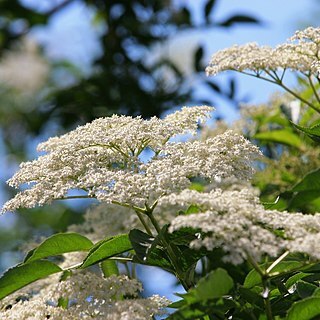Shrubs, small trees, or perennial herbs, gynodioecious or hermaphroditic, deciduous, whole plant sometimes with extrafloral nectariferous glands. Branches smooth, striate, or warty, with stout pith. Leaves with or without stipules, imparipinnate, or incompletely bipinnate, rarely laciniate; leaflets serrate or divided, opposite or alternate. Inflorescences terminal, flat or convex corymbs or panicles, pedunculate or sessile. Flowers actinomorphic or sometimes dimorphic, sometimes with glandular nectaries, articulate with pedicel; bracts mostly absent; bracteoles 1 or absent. Calyx tube: limb 3-5-parted; corolla rotate, white, lobes 3-5. Stamens 5, inserted at base of corolla; filaments erect, filiform; anthers 2-celled, oblong, cells free, attached at middle. Ovary locules 3-5, ovules 1 per locule; style cushionlike; stigmas 3 or 5. Fruit berrylike, 3-5-seeded; seeds triquetrous or ellipsoid; embryo ca. as long as seed.
Trees, shrubs, or erect herbs. Stem and branches pithy, nodes often with stipule-like appendages. Leaves imparipinnate, or incompletely bipinnate, rarely laciniate. Leaflets serrate or divided, opposite or alternate. Flowers actinomorphic, articulated with the pedicel, mostly white, in terminal, flat or convex corymbs; flowers sometimes dimorphic: gynodioecious, or part of them aborted into nectarial glands. Bracts mostly absent. Bracteoles 1 or absent. Calyx-tube short, limb 5-parted. Corolla rotate, 5-lobed, lobes valvate or imbricate(?). Stamens 5, inserted on the base of the corolla; filaments filiform, erect; anthers oblong, latrorse, cells free, attached in the middle. Ovary 3-5-celled, each cell with 1 ovule; stigmas 3 or 5, short, broad, on a cushion-like style. Berry 3-5-seeded. Seeds with ± flat sides, back convex, granulate, embryo ± as long as the seed, terete.
Small trees, shrubs or rarely perennial subshrubby herbs, mostly evil-smelling. Leaves pinnately or bipinnately compound; leaflets usually serrate; stipules absent, small or occasionally conspicuous, sometimes reduced to clusters of glands. Inflorescences usually terminal, corymbose, cymose or thyrsoid. Flowers small, regular. Corolla white or yellowish, rotate, the lobes imbricate or valvate. Stamens 5; filaments slender; anthers dehiscing outwards. Ovary 3–5-locular, with a single pendulous ovule in each locule; style wanting, the stigma sessile and 3–5-lobed. Fruit a berry-like drupe with 3–5 1-seeded pyrenes. Seeds with a membranous testa and fleshy endosperm.
Herbs, shrubs, or trees, sometimes sarmentose; branches with a soft, solid pith, the twigs glabrous or pubescent, often drying striate, sometimes purplish. Leaves opposite, evergreen, not connate, imparipinnately-divided,-the leaflets finely toothed, glabrous or pubescent with simple hairs and sometimes with subsessile glands which may dry reddish; the petiole sometimes gland-bearing, estipulate or with stipule-like glandular appendages, often slightly clasping the stem; petio-lules short, sometimes stipellate. Inflorescences terminal or axillary, held above
Deciduous shrubs or small trees, sometimes herbaceous, often spreading by suckers. Stems with thick pith. Winter buds with several pairs of scales. Lvs imparipinnate, stipulate or exstipulate. Fls in terminal corymbs or panicles, regular, (3)-5-merous, small. Calyx lobes very small. Corolla rotate. Stamens as many as corolla lobes, rarely 1 very reduced; filaments short and usually < corolla. Ovary 3-5-celled. Style very short or 0; stigma 3-5-lobed. Fr. a berry-like drupe with 3-5, compressed pyrenes.


